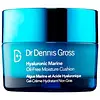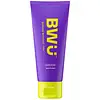What's inside
What's inside
 Key Ingredients
Key Ingredients

 Benefits
Benefits

 Concerns
Concerns

No concerns
 Ingredients Side-by-side
Ingredients Side-by-side

Water
Skin ConditioningCetearyl Alcohol
EmollientC13-16 Isoparaffin
SolventStearyl Dimethicone
EmollientDimethicone
EmollientButylene Glycol
HumectantCaprylic/Capric Triglyceride
MaskingGlyceryl Behenate
EmollientSodium Hyaluronate
HumectantCaulerpa Lentillifera Extract
Saccharide Isomerate
HumectantAloe Barbadensis Leaf Extract
EmollientTocopherol
AntioxidantCitrullus Lanatus Fruit Extract
Skin ConditioningCocos Nucifera Fruit Extract
EmollientCitrus Sinensis Fruit Extract
AntioxidantVaccinium Myrtillus Fruit/Leaf Extract
AstringentLactic Acid
BufferingGlycolic Acid
BufferingSaccharum Officinarum Extract
MoisturisingLeuconostoc/Radish Root Ferment Filtrate
AntimicrobialCitrus Aurantium Dulcis Fruit Extract
MaskingCitrus Limon Fruit Extract
MaskingAcer Saccharum Extract
Skin ConditioningCollagen Amino Acids
MoisturisingAdenosine
Skin ConditioningHydrolyzed Soy Protein
HumectantCopper PCA
HumectantIsohexadecane
EmollientHeptyl Undecylenate
EmollientEthylhexylglycerin
Skin ConditioningDimethicone Crosspolymer-3
Skin ConditioningIsododecane
EmollientOctadecene
SolventSodium Acrylate/Sodium Acryloyldimethyl Taurate Copolymer
Emulsion StabilisingPotassium Cetyl Phosphate
EmulsifyingSorbitan Oleate
EmulsifyingCeteareth-20
CleansingPolysorbate 80
EmulsifyingSodium Citrate
BufferingCitric Acid
BufferingBenzyl Alcohol
PerfumingPhenoxyethanol
PreservativeSodium Benzoate
MaskingPotassium Sorbate
PreservativeWater, Cetearyl Alcohol, C13-16 Isoparaffin, Stearyl Dimethicone, Dimethicone, Butylene Glycol, Caprylic/Capric Triglyceride, Glyceryl Behenate, Sodium Hyaluronate, Caulerpa Lentillifera Extract, Saccharide Isomerate, Aloe Barbadensis Leaf Extract, Tocopherol, Citrullus Lanatus Fruit Extract, Cocos Nucifera Fruit Extract, Citrus Sinensis Fruit Extract, Vaccinium Myrtillus Fruit/Leaf Extract, Lactic Acid, Glycolic Acid, Saccharum Officinarum Extract, Leuconostoc/Radish Root Ferment Filtrate, Citrus Aurantium Dulcis Fruit Extract, Citrus Limon Fruit Extract, Acer Saccharum Extract, Collagen Amino Acids, Adenosine, Hydrolyzed Soy Protein, Copper PCA, Isohexadecane, Heptyl Undecylenate, Ethylhexylglycerin, Dimethicone Crosspolymer-3, Isododecane, Octadecene, Sodium Acrylate/Sodium Acryloyldimethyl Taurate Copolymer, Potassium Cetyl Phosphate, Sorbitan Oleate, Ceteareth-20, Polysorbate 80, Sodium Citrate, Citric Acid, Benzyl Alcohol, Phenoxyethanol, Sodium Benzoate, Potassium Sorbate
Water
Skin ConditioningNiacinamide
SmoothingGlycerin
HumectantDipropylene Glycol
HumectantNeopentyl Glycol Diheptanoate
EmollientMethyl Trimethicone
Skin ConditioningPolyacrylate-13
Glyceryl Glucoside
HumectantXylitylglucoside
HumectantAnhydroxylitol
HumectantPseudoalteromonas Ferment Extract
HumectantPhenoxyethanol
PreservativePolyisobutene
Ophiopogon Japonicus Root Extract
Skin ConditioningChlorphenesin
AntimicrobialArachidyl Alcohol
EmollientGlyceryl Dibehenate
EmollientXylitol
HumectantTribehenin
EmollientBehenyl Alcohol
EmollientGlyceryl Behenate
EmollientArachidyl Glucoside
EmulsifyingPolysorbate 20
EmulsifyingPentylene Glycol
Skin ConditioningMadecassoside
Antioxidant1,2-Hexanediol
Skin ConditioningCaprylyl Glycol
EmollientPhospholipids
Skin ConditioningCyanocobalamin
Skin ConditioningSphingolipids
EmollientSodium Citrate
BufferingP-Anisic Acid
MaskingTocopherol
AntioxidantWater, Niacinamide, Glycerin, Dipropylene Glycol, Neopentyl Glycol Diheptanoate, Methyl Trimethicone, Polyacrylate-13, Glyceryl Glucoside, Xylitylglucoside, Anhydroxylitol, Pseudoalteromonas Ferment Extract, Phenoxyethanol, Polyisobutene, Ophiopogon Japonicus Root Extract, Chlorphenesin, Arachidyl Alcohol, Glyceryl Dibehenate, Xylitol, Tribehenin, Behenyl Alcohol, Glyceryl Behenate, Arachidyl Glucoside, Polysorbate 20, Pentylene Glycol, Madecassoside, 1,2-Hexanediol, Caprylyl Glycol, Phospholipids, Cyanocobalamin, Sphingolipids, Sodium Citrate, P-Anisic Acid, Tocopherol
Ingredients Explained
These ingredients are found in both products.
Ingredients higher up in an ingredient list are typically present in a larger amount.
Glyceryl Behenate is a fatty acid created from glycerin and behenic acid. It is an emollient and emulsifier.
This ingredient may not be Malassezia folliculitis, or fungal acne safe.
Phenoxyethanol is a preservative that has germicide, antimicrobial, and aromatic properties. Studies show that phenoxyethanol can prevent microbial growth. By itself, it has a scent that is similar to that of a rose.
It's often used in formulations along with Caprylyl Glycol to preserve the shelf life of products.
Sodium Citrate is the sodium salts of citric acid. In skincare, it is used to alter pH levels and acts as a preservative.
Its main functions are to maintain the pH of a product and neutralize metal ions.
The acidity of our skin is maintained by our glands and skin biome; normal pH level of skin is slightly acidic (~4.75-5.5).
Being slightly acidic allows our skin to create an "acid mantle". This acid mantle is a thin barrier that protects our skin from bacteria and contaminants.
Learn more about Sodium CitrateTocopherol (also known as Vitamin E) is a common antioxidant used to help protect the skin from free-radicals and strengthen the skin barrier. It's also fat soluble - this means our skin is great at absorbing it.
Vitamin E also helps keep your natural skin lipids healthy. Your lipid skin barrier naturally consists of lipids, ceramides, and fatty acids. Vitamin E offers extra protection for your skin’s lipid barrier, keeping your skin healthy and nourished.
Another benefit is a bit of UV protection. Vitamin E helps reduce the damage caused by UVB rays. (It should not replace your sunscreen). Combining it with Vitamin C can decrease sunburned cells and hyperpigmentation after UV exposure.
You might have noticed Vitamin E + C often paired together. This is because it is great at stabilizing Vitamin C. Using the two together helps increase the effectiveness of both ingredients.
There are often claims that Vitamin E can reduce/prevent scarring, but these claims haven't been confirmed by scientific research.
Learn more about TocopherolWater. It's the most common cosmetic ingredient of all. You'll usually see it at the top of ingredient lists, meaning that it makes up the largest part of the product.
So why is it so popular? Water most often acts as a solvent - this means that it helps dissolve other ingredients into the formulation.
You'll also recognize water as that liquid we all need to stay alive. If you see this, drink a glass of water. Stay hydrated!
Learn more about Water